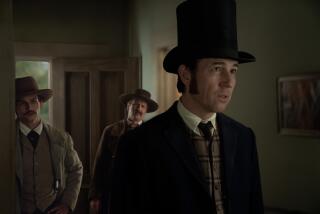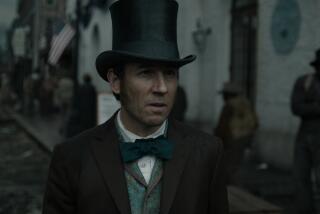Our Times / Orange County Communities
You know this man: Lincoln, Abraham Lincoln. Sixteenth president of the United States, Great Emancipator and, to the point here, the face on the new $5 bill.
Itâs Abe, surely, but not the Abe you grew up with. Itâs not the Abe who has been on the five since World War I. That would be the contemplative philosopher king of the Lincoln Memorial, a man of intellectual gravity who wore the burdens of leadership in the heavy lines of his face, in the deep shadows of his eyes wherein one artist of the day saw âan inexpressible sadness.â
Next time youâre waiting in the checkout line, pull out a new $5 bill and introduce yourself to a subtly new Abe, an unburdened Abe, a 98% melancholy-free Abe. Meet Abe Lite.
The strain of Lincolnian sadness has been replaced by something else. A certain elan, you might say. Suddenly, the left eyebrow is lifted in a manner evoking Claude Rains in âCasablanca.â Suddenly, the left corner of the mouth turns up just enough to make you wonder if A. Lincoln isnât morphing into George W.
You look at this Abe, you donât hear him saying: âThe world will little note, nor long remember, what we say here . . .â Youâre more apt to hear: âMan, but that Gettysburg speech was good, wasnât it?â
You change an angle of lip, a shadow of brow, a turn of the head or cast of the eyes, and pretty soon, if you havenât lost the physical likeness, youâve changed the persona. Itâs a subtle matter, but this is the nature of portraiture. A saintly face so easily turns shifty, a humble fellow turns haughty.
Abe Liteâs been in circulation about a month now, part of the U.S. Treasury and Federal Reserveâs continuing revamping of the paper money. As with the $100, $50, $20 and $10, the portrait on the $5 note has been changed, enlarged and shifted slightly to the left. Hidden security features have been added to foil counterfeiters.
In none of the other newly redesigned bills, however, does the new portrait convey a much different persona. With Abe, the difference is a combination of the photograph used as source material and the engraverâs interpretation.
Frederick Voss, the senior historian at the National Portrait Gallery in Washington, agrees that the new and old $5 bills evoke different personas. In his view, the new Abe suggests âa little more sense of force . . . sort of an aggressiveness, a toughness, which we really donât associate with Lincoln, particularly in this later period.â
True, Lincoln was a determined leader who carried on a very costly war. Still, Voss says, something in the new Abe is not quite what usually comes to mind when youâre thinking Lincoln. He canât quite put his finger on the word.
A swagger, perhaps?
âYeah, itâs a good word,â says Voss. âA swagger.â
*
Tom Schwartz, secretary of the Abraham Lincoln Assn. and also the Illinois state historian, says the difference between the two Abes is a matter of gravity. As he sees it, the old one has it and the new one doesnât. Like the rest of the new money, the $5 seems to him âcartoonish,â with ânone of the character and dignity that you find in the original $5 bill.â
The two $5 Abes are variations on a man whose demeanor in life was said to shift with remarkable swiftness. A Lincoln acquaintance, Dr. James Miner, is quoted describing Lincolnâs face in repose as âunspeakably sad,â his eyes âas expressionless as those of a dead fish; but when he smiled or laughed at one of his own stories or that of another, then everything about him changed; his figure became alert, a lightning change came over his countenance. . . . I thought he had the most expressive features I had ever seen on the face of a man.â
*
The owner of this most remarkable face on the afternoon of Feb. 9, 1864, made the short trip from the White House to the Pennsylvania Avenue studio of photographer Mathew Brady. That day, Bradyâs associate, Anthony Berger, made seven photographs of Lincoln. These included the portrait used as the basis for the new $5 bill, the profile used as the model for the U.S. penny and the portrait that appeared on the old five, the picture that the presidentâs son Robert T. Lincoln considered âthe most satisfactory likeness of him.â
So why change it?
Jack Ruther, a bank note designer at the Bureau of Engraving and Printing, says it was a matter of consistency. The portraits were changed in all the bill redesigns but that of Ulysses S. Grant on the $50. Ruther says there just were not enough good images of Grant to work with.
The same cannot be said of Lincoln, whose fascinating face was quite the object of photographic attention. The seven photographs Berger made that day were among 119 separate photographs of Lincoln by 31 different photographers recorded in a definitive account published in 1963 by Charles Hamilton and Lloyd Ostendorf.
The new $5 photo differs from the old in several respects. In the âold $5â photo, Lincoln is seated with his face and body at the same angle to the camera, his face cast down ever so slightly, his eyes set on the distance to the photographerâs right. In the ânew $5â photo, Lincolnâs body is angled to the cameraâs left, while his face, lifted just a tad, turns the opposite way. The turn, however slight, conveys action and determination.
Thereâs quite a bit of dark shadow beneath Lincolnâs brow, on his left cheekbone and the left side of his mouth. This both obscures his features and softens them. In their commentary on the photograph, Hamilton and Ostendorf say the photograph reveals âjust a faint suggestion of merriment in his sparkling eyes, as though a smile were about to ignite his masklike features.â
On the bill, with the shadows removed in the interest of clarity, the lifted left eyebrow and upturn in the left corner of the mouth suggest a certain self-satisfaction, perhaps even irony. Darn if Abe doesnât seem just a bit cocky.
The engraver, William Fleishell, doesnât see it that way. He acknowledges taking âcertain libertiesâ to make a clear image and to make the portrait stand out against the background but doesnât figure heâs rendered a very different Abe.
âI concentrated on the eyes in the new one,â says Fleishell, trying to render them âalmost wistful, almost as if heâs staring off into the future.â
A gaze of self-assurance, for sure. A new Abe for an all-knowing information age. Not necessarily the man who, two months after sitting for Bergerâs photographs, wrote to a Kentucky newspaper editor: âI claim not to have controlled events, but confess plainly that events have controlled me.â
More to Read
Sign up for Essential California
The most important California stories and recommendations in your inbox every morning.
You may occasionally receive promotional content from the Los Angeles Times.










